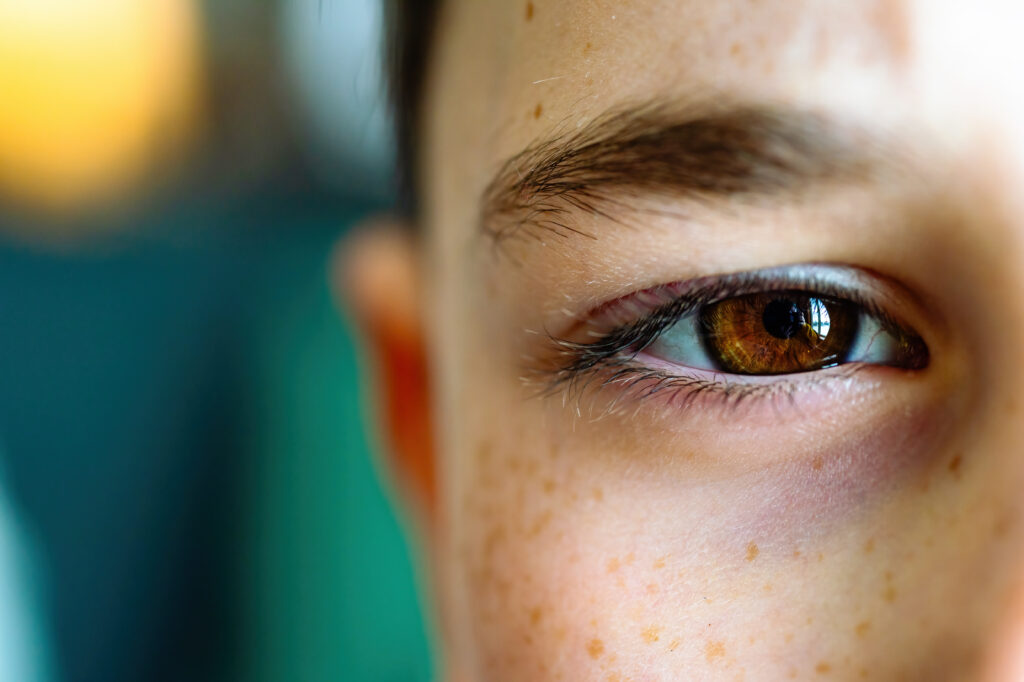Development of Vision

The development of vision, or how we perceive and interpret visual stimuli, is a complex process that unfolds over time. Vision development occurs both during early infancy and throughout childhood. Here’s a breakdown of how vision develops:
Prenatal Development of Vision
Weeks 4-6: The basic structure of the eyes starts forming early in fetal development. The optic nerve, lens, and retina begin to take shape.
Week 7: The retina starts developing photoreceptors (rods and cones), but they are not yet fully functional.
At Week 16: The fetus begins to respond to light, though it’s very dim and doesn’t allow for detailed vision.
Week 24-28: At this point, the fetus’s eyes can detect light and dark, but vision is still very limited.
Birth to 2 Months
Limited Vision: Newborns can only see high-contrast shapes and faces at close range, typically about 8 to 12 inches away (roughly the distance between a mother’s face and the baby during breastfeeding).
Focus: Newborns’ ability to focus is not fully developed, and they typically only focus on things that are very close.
Tracking Movement: They begin to track slow-moving objects with their eyes, but still struggle with smooth and coordinated eye movements.
Tummy time is crucial for many things related to development, but it also helps the development of vision. So make sure you are getting at least 30 minutes of tummy time every day!
2 to 6 Months
Improved Focus: By around 2 months, infants can focus better and begin tracking objects across a wider field of view.
Color Vision: At about 3 months, babies can distinguish between different colors, although they are more sensitive to some colors (like red) than others (like blue).
Depth Perception: Around 3-5 months, babies develop binocular vision, meaning they can use both eyes together to perceive depth and distance.
Visual Acuity: The sharpness of vision improves as the retina and brain’s visual centers develop. However, it still takes time for them to develop perfect acuity.
6 to 12 Months
Object Permanence: At this stage, babies understand that objects continue to exist even when they are out of sight. Vision plays a crucial role in this cognitive development.
Hand-Eye Coordination: Infants begin to develop better hand-eye coordination, which is essential for reaching, grasping, and exploring objects.
Improved Depth Perception: Depth perception continues to improve, and babies can now navigate more efficiently, using visual cues to assess distances.
12 to 24 Months
Improved Visual Tracking: At this stage, toddlers can track fast-moving objects more easily and begin to recognize faces and objects from a distance.
Fine Visual Discrimination: Toddlers can now differentiate between similar objects, recognize shapes, colors, and even some letters or numbers.
Development of Vision from 3 to 5 Years
Sharpness of Vision: Visual acuity continues to develop and should approach near adult levels by age 3. Most children will have 20/20 vision by age 5 or 6.
Visual Memory: Children start to recognize and remember details of images and scenes, which is foundational for things like reading and recognizing familiar places or people.
Spatial Awareness: They develop better spatial awareness and understand where they are in relation to other objects, which is essential for activities like drawing and playing sports.
6 to 12 Years
Refined Depth Perception: By this age, depth perception is more precise and helps in tasks like riding a bike, catching a ball, and understanding complex spatial relationships.
Reading and Writing: Visual processing skills continue to improve, allowing children to recognize letters and words quickly, as well as interpret more complex visual cues like graphs or maps.
Binocular Vision Stabilization: Eye coordination and alignment become more stable, helping children to avoid issues like strabismus (crossed eyes).
Development of Vision in Adolescence and Beyond
Mature Visual Processing: By adolescence, vision reaches full maturity. The brain has learned how to interpret visual input accurately, integrating the various visual systems.
Potential for Changes: While vision is stable in young adulthood, environmental factors, age, or certain conditions (like nearsightedness or farsightedness) can affect vision later in life.
What key points of vision should a parent look for, and who can they see if their child is struggling? One key aspect that develops gradually but is critical for learning is binocular vision. This is the coordination between both eyes that allows for depth perception. Secondly, eye-hand coordination is critical for all fine motor tasks from small to complex. If your child is struggling with poor hand-eye coordination, difficulty copying text, poor penmanship, reversed letters/numbers after the age of 6 or 7, or difficulty completing mazes or ISpy books then an occupational therapy evaluation may be recommended to assess your child’s visual motor skills. If vision problems are detected early (such as crossed eyes, poor focus, or inability to track moving objects), they can often be addressed with interventions, ensuring proper development. Get more information on visual motor skills visit at the OT Tool Box.
